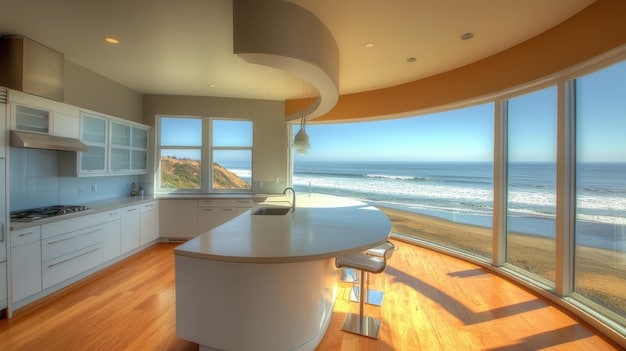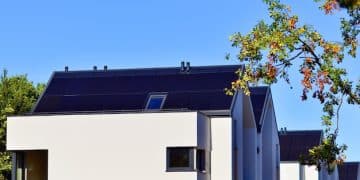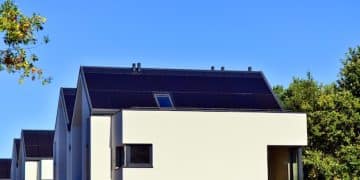Maximize Natural Light: Energy-Efficient Home Design Strategies

Maximize natural light in your home through strategic design to enhance energy efficiency, reduce electricity costs, and create a brighter, more inviting living space.
Transform your living space into a bright, energy-efficient haven by learning how to maximize natural light. Discover innovative design strategies to boost comfort, cut energy costs, and create a home that’s both beautiful and sustainable.
The Benefits of Natural Light in Home Design
Natural light offers numerous benefits for your home and well-being. Designing to maximize this resource can significantly impact your energy consumption, mood, and overall living experience. Properly integrated, natural light can transform a house into a comfortable, energy-efficient space.
Let’s explore the advantages of making natural light a priority in your home design.
Energy Savings
One of the most significant advantages of maximizing natural light is reduced energy consumption. By allowing daylight to illuminate your home, you can decrease your reliance on artificial lighting during the day.
Improved Well-Being
Exposure to natural light has a positive impact on both physical and mental health. Sunlight helps regulate your body’s circadian rhythm, improving sleep quality and boosting your mood.
- Natural light can increase productivity and focus.
- It can alleviate symptoms of seasonal affective disorder (SAD).
- Exposure to sunlight helps your body produce vitamin D, essential for bone health and immune function.
Harnessing natural light is not just about aesthetics; it’s a holistic approach to creating a healthy and sustainable living environment. As you explore design strategies, think about how each element can contribute to both energy efficiency and your personal well-being.

Strategic Window Placement for Optimal Sunlight
Window placement is crucial when designing for maximum natural light. The direction your windows face significantly affects the amount and type of light received throughout the day. Thoughtful planning ensures you capture as much daylight as possible while minimizing unwanted heat gain.
Knowing how to orient your windows is key to optimizing natural light in your home.
South-Facing Windows
South-facing windows are ideal for capturing the most sunlight throughout the year. In the Northern Hemisphere, the sun is generally higher in the southern sky, making these windows prime candidates for maximizing daylight.
East- and West-Facing Windows
East-facing windows receive direct sunlight in the morning, while west-facing windows get intense afternoon sun. Both orientations can provide valuable natural light, but they also come with potential drawbacks.
Strategic window placement should consider your local climate, the surrounding landscape, and your daily routines to ensure you harness the benefits of natural light while minimizing any negative impacts.
Choosing the Right Window Types
Selecting the appropriate window types is essential for maximizing natural light and enhancing energy efficiency. Different window styles offer varying degrees of light transmission, ventilation, and insulation. Choosing the right ones can drastically improve the comfort and sustainability of your home.
Here are some popular window types and their benefits:
- Casement Windows: These windows are hinged on the side and swing outward, providing excellent ventilation and unobstructed views. Their tight seal also contributes to energy efficiency.
- Double-Hung Windows: With two operable sashes that slide vertically, double-hung windows offer versatile ventilation options. They are easy to clean and can be fitted with energy-efficient glass.
- Skylights: Installed on the roof, skylights bring in direct sunlight from above, illuminating interior spaces that windows cannot reach. They are perfect for maximizing light in rooms with limited wall space.
Selecting the right window type involves considering your priorities – whether it’s maximizing light, improving ventilation, or enhancing energy efficiency. By weighing these factors, you can choose windows that not only brighten your home but also contribute to its overall sustainability.

Interior Design Strategies to Enhance Natural Light
Once you have optimized window placement and chosen the right window types, the next step is to implement interior design strategies that enhance the natural light within your home. The colors, materials, and layout of your interior spaces can significantly impact how light is reflected and distributed.
Strategic interior design can amplify the effects of natural light, creating a brighter and more inviting atmosphere.
Color Palette
The colors you choose for your walls, ceilings, and floors play a crucial role in reflecting light. Light and neutral colors, such as white, cream, and pale gray, are excellent at bouncing light around the room.
Mirror Magic
Mirrors are a powerful tool for enhancing natural light. Strategically placed mirrors can reflect and redirect sunlight, making a room feel larger and brighter.
By carefully selecting colors, incorporating reflective surfaces, and decluttering your space, you can create an interior that maximizes the benefits of natural light, enhancing both the aesthetics and energy efficiency of your home.
Landscaping for Light and Energy Efficiency
Landscaping around your home can significantly impact the amount of natural light you receive and your overall energy efficiency. Trees, shrubs, and other plants can either block sunlight or provide shade, depending on their placement. Thoughtful landscaping can help you maximize light while minimizing heat gain.
Here’s how to use landscaping to enhance natural light:
- Deciduous Trees: Planting deciduous trees (those that lose their leaves in the fall) on the south side of your home can provide shade during the hot summer months and allow sunlight to filter through in the winter.
- Reflective Surfaces: Use light-colored gravel or paving materials around your home to reflect sunlight onto your walls and into your windows.
- Strategic Shrubbery: Place low-growing shrubs strategically to avoid blocking sunlight to your windows. Prune existing shrubs regularly to maintain an open path for light.
By carefully planning your landscaping, you can strike a balance between providing shade for energy efficiency and allowing ample natural light to brighten your home. This approach not only enhances comfort but also contributes to a more sustainable and visually appealing property.
Balancing Light and Heat: Managing Solar Gain
While maximizing natural light is desirable, it’s crucial to manage solar gain to prevent overheating, especially during the summer months. Excessive solar gain can increase your air conditioning costs and create an uncomfortable living environment. Implementing effective strategies to balance light and heat is key to achieving energy efficiency.
Here are some effective methods for managing solar gain:
Window Treatments
Window treatments are a versatile tool for controlling the amount of sunlight entering your home. Blinds, shades, and curtains can be adjusted to block or diffuse light as needed.
Low-E Coatings
Low-emissivity (Low-E) coatings are thin, transparent layers applied to window glass. These coatings reduce the amount of heat that passes through the glass while allowing visible light to enter.
By using window treatments, Low-E coatings, and awnings, you can effectively manage solar gain, ensuring your home remains comfortable and energy-efficient throughout the year. These strategies help you harness the benefits of natural light without the drawbacks of excessive heat.
| Key Point | Brief Description |
|---|---|
| ☀️ Strategic Window Placement | Maximize sunlight by orienting windows south for consistent light and managing east/west windows for heat. |
| 💡 Interior Design Choices | Use light colors, mirrors, and decluttering to reflect light and brighten spaces. |
| 🌳 Landscaping Strategies | Plant deciduous trees to shade in summer and allow light in winter; use reflective materials. |
| 🛡️ Managing Solar Heat | Control heat with window treatments, Low-E coatings, and awnings to balance light and comfort. |
Frequently Asked Questions
▼
South-facing windows are generally the best for maximizing sunlight as they receive the most consistent light throughout the day, especially in the Northern Hemisphere.
▼
Light colors like white, cream, and pale gray reflect light, helping to distribute it more evenly throughout the room and making the space feel brighter.
▼
Low-E (low-emissivity) coatings are thin layers on window glass that reduce heat transfer, keeping your home cooler in summer and warmer in winter, thus saving energy.
▼
Yes, landscaping can significantly impact light. Deciduous trees can shade your home in summer and allow sunlight through in winter, and reflective surfaces can bounce light into windows.
▼
Blinds, shades, and curtains are effective for managing solar gain. They can be adjusted to block or diffuse sunlight as needed, helping to keep your home cool.
Conclusion
By strategically implementing these design strategies, you can maximize natural light in your home, creating a brighter, more energy-efficient living space that enhances your well-being and reduces your carbon footprint. Embrace the sun and transform your home into a sustainable sanctuary.





